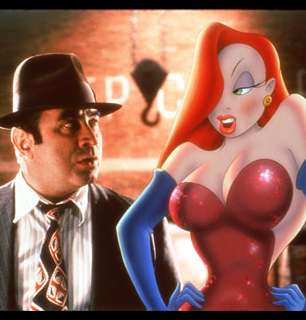Toon
"Tonight's forecast: Partly cloudy with a chance of safes, pianos, and anvils."
On the Internet, "toon" is usually a short qualifier for any animated character done in a North American style.
More specifically, a Toon is a character whose personality (and usually appearance) is greatly exaggerated. Even for the The Comically Serious, comedy colors everything the character does and he is often unable to complete the most basic tasks without falling victim to a number of improbable variables. A probable reason is that many thrive on a consistent, tolerated kind of chaos.
The few animated shows in the West that attempt drama, such as King of the Hill, shy away from using certain tropes associated with Toons in an effort to be taken seriously. See Animation Age Ghetto. For obvious reasons, this is a lot more capricious in anime.
The most famous example is probably the universe portrayed in Who Framed Roger Rabbit? (which The Other Wiki says is the Trope Namer).
The word "Toon" may be used interchangeably with "Character" in some MMORPGs. As in, "Which toon do you want me to play for this raid, my fighter or my cleric?". This especially applies to Toontown Online, in which this is actually what the players are officially called in-game.
The tabletop roleplaying game Toon was inspired by the more slapstick examples of this trope.
Not to be confused with Newcastle United.
Anime and Manga
- In Yu-Gi-Oh!, Pegasus uses a card called "Toon World", which turns his monsters into toons. They also do this to other player's monsters, if Pegasus takes hold of them... which infuriates Kaiba when it happens to his Blue-Eyes White Dragon.
- Made even worse in the anime and manga in that they can abuse Toon Physics to do things like contort to dodge attacks, or quite frankly do the impossible (such as a Barehanded Blade Block from an armless clamshell in Toon Mermaid's case in the anime).
- Also made worse in the actual card game in that they have the fantastic ability to, no matter how powerful, be able to hop right over the enemy monsters and attack the opponent directly, provided there isn't a Toon on their side of the field. The fact that Toon monsters are typically Special Summoned, meaning you can easily get the biggest monsters (Toon Summoned Skull, and Toon Dark Magician Girl, and Blue Eyes Toon Dragon) out in ONE TURN. Offset by the fact that they (usually) need to wait a turn before they can attack . . . with the notable exception of 2000 ATK Toon Dark Magician Girl.
- However, the effects of the official card game's Toons are more than offset by the numerous costs, drawbacks, and restrictions on them, to the point that they're considered useless to most competent duelists.
- The Abridged Series had a field day with this, especially with Toon Dark Magician Girl.
Film
- Most of Walt Disney's longest-running non-feature characters are traditional toons; until late 2008, Disney had done away with hand-drawn cel animation and converted to CGI. Disney execs recently (as of early 2009) announced Disney's return to 'traditional' forms of animation, saying that if any company is going to preserve the art of hand-drawn animation, it should be Disney.
- Arguably, the Disney non-feature characters are not toons in the comics, where we often have to take them quite seriously in dramatic situations. It's almost painful for anyone raised on the comics continuity to chat with those who view Mickey Mouse, Donald Duck, and Uncle Scrooge as wacky, one-dimensional clowns.
- Who Framed Roger Rabbit? has toons living in the same world as humans and being treated poorly by them
- The above is subverted in Last Action Hero, in which Jack Slater describes the cartoon cat Whiskers as one of the best guys on the force. He has a few overexaggerated mannerisms, but nothing that wouldn't fit on a human. Whiskers later saves his life by shooting the bad guy threatening him.
- The Ralph Bakshi film Cool World is an example of a blend of different styles. Most of the cartoon characters (referred to as "Doodles" in-universe) fall under this distinction, with the exception of Holli Wood and other more human characters.
Literature
Western Animation
- All famous Warner Brothers characters are, too.
- Most of the cartoons that came out during The Golden Age of Animation qualify.
- The Disney series Bonkers was about a cartoon cat who joined an all-human police force, and drove his human partner to distraction with his zany cartoon antics, in a fairly obvious pastiche—if not a shared universe—of Who Framed Roger Rabbit?. However, since the show itself was animated, the proper effect was achived by giving all the normal human characters subdued and muted color schemes.
- Drawn Together's Wooldor Sockbat represents the classic Toon. Everything he does is zany (including masturbation) and explained as a desperate need to be liked.
- Most classic Nicktoons fall into this category.
- Toon Disney, in its heyday, aired exclusively Western Animation, mainly from Disney, and in its promos featured the word "toon." Except the word "toon" can come off as ambiguous in them; it can mean the programming featured, as in "around the clock toons," or the characters in said programming, as in its slogan "built from the best toons."
